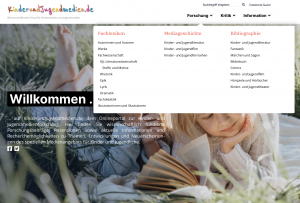 Fast ein ganzes Jahr hat es gedauert: Rechtzeitig zum zehnten Geburtstag des Portals im Jahr 2022 haben wir KinderundJugendmedien.de grundlegend überarbeitet. Das Portal zur Kinder- und Jugendmedienforschung, das ich mitgegründet habe und als stellvertretender Chefredakteur mitleite, erstrahlt nun in neuem Gewand – mit verbesserter Benutzerführung und einer neuen Datenbankfunktion. Mehr Infos hier.
Fast ein ganzes Jahr hat es gedauert: Rechtzeitig zum zehnten Geburtstag des Portals im Jahr 2022 haben wir KinderundJugendmedien.de grundlegend überarbeitet. Das Portal zur Kinder- und Jugendmedienforschung, das ich mitgegründet habe und als stellvertretender Chefredakteur mitleite, erstrahlt nun in neuem Gewand – mit verbesserter Benutzerführung und einer neuen Datenbankfunktion. Mehr Infos hier.
Archiv des Autors: nietzschenstein_67
Handbuch Kinder- und Jugendliteratur

Im Oktober 2020 ist endlich das von mir und Tobias Kurwinkel herausgegebene Handbuch Kinder- und Jugendliteratur im Metzler-Verlag erschienen.
Es informiert umfassend über die Literatur für Kinder und Jugendliche in verschiedenen Medien und fasst den Stand der Forschung in diesem Bereich sowohl diachron als auch synchron zusammen. Es deckt eine Vielzahl von Erzählmedien wie Bilderbuch, Computerspiel, Film oder Theater ab und akzentuiert aktuelle Themen wie All Age-Literatur, Medien- und Produktverbund sowie Inter- und Transmediales, Digitales und Serielles Erzählen. Methodische Zugänge und kulturwissenschaftliche Aspekte werden ebenfalls thematisiert, der Didaktik ist ein eigenes Kapitel gewidmet.
Weitere Informationen finden sich hier:
https://www.springer.com/de/book/9783476047205
Handbuch Kinder- und Jugendliteratur
Hrsg. von Tobias Kurwinkel und Philipp Schmerheim.
Unter Mitarbeit von Stefanie Jakobi.
Stuttgart: Metzler, 2020.
Zwischen Kindheitsnostalgie und Film-Spielen in digital(isiert)en Welten: Jim Knopf, Offline und der aktuelle deutsche Kinder- und Jugendfilm
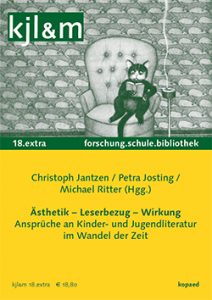 In der kjl&m.extra 2018 untersuche ich zwei nur scheinbar gegensätzliche narratoästhetische Entwicklungen des deutschsprachigen Kinder- und Jugendfilms: Erstens instrumentalisieren aktuelle Filme wie Jim Knopf und Lukas der Lokomotivführer oder Timm Thaler die Kindheitsnostalgie von älteren bzw. medienerfahreneren Rezipierenden, indem sie auf Ästhetik, Erzählstrategien und Motive früherer Adaptionen zurückgreifen. Andere Filme rekurrieren auf digitale Lebensräume, sind in digitalen Welten angesiedelt oder nutzen Level-Strukturen. Dies sind – so die These – Versuche, erlebte und erinnerte kindlich-jugendliche Lebenswelten einzubeziehen.
In der kjl&m.extra 2018 untersuche ich zwei nur scheinbar gegensätzliche narratoästhetische Entwicklungen des deutschsprachigen Kinder- und Jugendfilms: Erstens instrumentalisieren aktuelle Filme wie Jim Knopf und Lukas der Lokomotivführer oder Timm Thaler die Kindheitsnostalgie von älteren bzw. medienerfahreneren Rezipierenden, indem sie auf Ästhetik, Erzählstrategien und Motive früherer Adaptionen zurückgreifen. Andere Filme rekurrieren auf digitale Lebensräume, sind in digitalen Welten angesiedelt oder nutzen Level-Strukturen. Dies sind – so die These – Versuche, erlebte und erinnerte kindlich-jugendliche Lebenswelten einzubeziehen.
About this website
Kurzmitteilung
Welcome to my website, which showcases my research and teaching activities on storytelling across media for children and young adults, with a particular emphasis on literature, film, comics, and theatre. My other research focus is in the fields of film theory and film philosophy. I work as an assistant professor at the German literature department of the University of Hamburg.
Doppelsinnigkeit für Kinderphilosophen
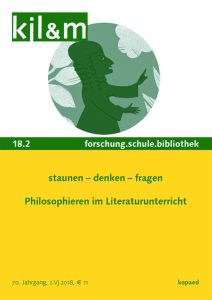 Kinderphilosophische Erzähltexte können eine philosophische Gesprächsgemeinschaft zwischen Kindern und Erwachsenen generieren, wenn sie an den philosophischen Impuls von Kindern anknüpfen und zugleich mit den Vorkenntnissen älterer Rezipienten spielen. In einem Beitrag in der Zeitschrift kjl&m (Ausgabe 18.2) untersuche ich im Anschluss an grundlegende Überlegungen exemplarisch die von Doppelsinnigkeit und Mehrfachadressierung geprägten kinderphilosophischen Erzählstrategien der Buchreihe Platon und Co. Mehr Informationen finden Sie hier.
Kinderphilosophische Erzähltexte können eine philosophische Gesprächsgemeinschaft zwischen Kindern und Erwachsenen generieren, wenn sie an den philosophischen Impuls von Kindern anknüpfen und zugleich mit den Vorkenntnissen älterer Rezipienten spielen. In einem Beitrag in der Zeitschrift kjl&m (Ausgabe 18.2) untersuche ich im Anschluss an grundlegende Überlegungen exemplarisch die von Doppelsinnigkeit und Mehrfachadressierung geprägten kinderphilosophischen Erzählstrategien der Buchreihe Platon und Co. Mehr Informationen finden Sie hier.
The film adventures of Paul Maar’s “Das Sams”
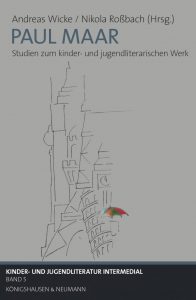 Almost every German knows Paul Maar’s stories about Das Sams – a strange little creature, a kind of hybrid between Alf and a wish fairy, which more or less happens upon a middle-aged, reclusive man called Bruno Taschenbier. For reasons I am unwilling to explain here (you’ll have to read up on it by yourself), Taschenbier is adopted by the Sams as his “Papa”, which, apart from causing a lot of chaos in his hitherto quiet and boring life, has its benefits, since The Sams finds itself in the possession of a lot of blue freckles on its face, and with every freckle it is able to grant a wish to Bruno Taschenbier. Each of those, however, must be formulated precisely, otherwise… well, see the above concerning chaos.
Almost every German knows Paul Maar’s stories about Das Sams – a strange little creature, a kind of hybrid between Alf and a wish fairy, which more or less happens upon a middle-aged, reclusive man called Bruno Taschenbier. For reasons I am unwilling to explain here (you’ll have to read up on it by yourself), Taschenbier is adopted by the Sams as his “Papa”, which, apart from causing a lot of chaos in his hitherto quiet and boring life, has its benefits, since The Sams finds itself in the possession of a lot of blue freckles on its face, and with every freckle it is able to grant a wish to Bruno Taschenbier. Each of those, however, must be formulated precisely, otherwise… well, see the above concerning chaos.
First published in 1973, it took decades before the author finally agreed to a film adaptation of his book series. For the wonderful edited volume on Paul Maar – Studien zum kinder- und jugendliterarischen Werk (edited by Andreas Wicke and Nikola Roßbach) I have written a little essay on the film adaptations, which are interesting from a narratological perspective since the first film combines the content and story structure of the first three books within 90 minute’s screen time.
Multiperspectival narration in Raquel J. Palacio’s “Wonder”
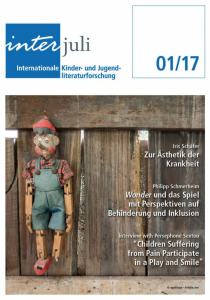 I have written an article on multiperspectival narration in Raquel Palacio’s novel Wonder for the international poen access journal interjuli. The German-language article explores the idea that recent disability narratives gravitate towards more complex forms of storytelling, in this case: towards employing multiple narrators or narrational perspectives. The issue of interjuli contains a number of other wonderful entries.
I have written an article on multiperspectival narration in Raquel Palacio’s novel Wonder for the international poen access journal interjuli. The German-language article explores the idea that recent disability narratives gravitate towards more complex forms of storytelling, in this case: towards employing multiple narrators or narrational perspectives. The issue of interjuli contains a number of other wonderful entries.
You can download the article here.
Essay on Artificial Humans in Young Adult Literature
 Sabine Planka has edited the English-language edited volume Critical Perspectives on Artificial Humans in Children’s Literature (Königshausen & Neumann, 2016) whose contributions explore the sophisticated ways in which children’s literature deals with the idea of artificial human beings, and how society, social fears and wishes are reflected and integrated within it. I have contributed an essay to that volume: „Dystopias of Creation: The Evolution of Artificial Humans in Contemporary Young Adult Literature“.
Sabine Planka has edited the English-language edited volume Critical Perspectives on Artificial Humans in Children’s Literature (Königshausen & Neumann, 2016) whose contributions explore the sophisticated ways in which children’s literature deals with the idea of artificial human beings, and how society, social fears and wishes are reflected and integrated within it. I have contributed an essay to that volume: „Dystopias of Creation: The Evolution of Artificial Humans in Contemporary Young Adult Literature“.
In the article, I argue that, apart from mirroring the growing relevance of scientific research as well as popular-cultural discourse on artificial intelligence (AI) in societies across the globe, literature has played an integral role in fleshing out the consequences of human attempts to generate new forms of sentience. Young Adult Literature adds a specific perspective to the long tradition of occidental storytelling about artificial (human) beings, since its focus on non-adult characters allows exploring the similar challenges shared by adolescents and artificial humans alike: Growing up in a world they are not entirely integrated into yet, embodying a body that still not feels entirely owned, searching for an identity that feels fully theirs. This continues as well as evolves the occidental tradition of telling stories about artificial beings throughout the history of literature and film. Consequently, my article traces the transformations and evolutions of artificial beings in Young Adult Literature, based on a historical overview, followed up by case studies of two recent artificial intelligence narratives: Karl Olsberg’s Rafael 2.0 (2011) and Mary E. Pearson’s Jenna Fox Chronicles (2008-2013).
Introducing KinderundJugendmedien.de on kjl&m
I have written a short entry introducing KinderundJugendmedien.de – our website dedicated to research in children’s literature, film, and other media – in the most recent issue 16.3 of the children’s media research journal kjl&m. You can find the entry here. There’s also another entry on KinderundJugendmedien.de published in CLOSURE – a German-language digital journal decdicated to Comics research (lookahere).
Review of Felix Giesa: Graphisches Erzählen von Adoleszenz
I have written a review of Felix Giesa’s book „Graphisches Erzählen von Adoleszenz“, an extensive study of German-language comics that deal with topics of adolescence. You can find the review in issue 2.5 of the comics research eJournal CLOSURE and on KinderundJugendmedien.de.
